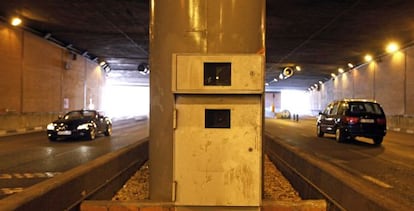Radar speed checks: is safety or revenue the main concern?
New report suggests clearly signaling speed traps slows motorists down


Motorists trying to avoid speeding fines will be keen to get their hands on the latest report by the Associated European Motorists (AEA) that lists the 25 busiest speed traps in Spain.
The list, which is based on 5,000 fines issued by the Civil Guard and the Catalan and Basque Country regional police forces over the last six months, is divided among six regions.
Madrid has four traps on the list: at kilometer 22.1 on the A1 northbound; kilometer 15 on the A2 eastbound; kilometer 13.3 on the A4 eastbound; and northbound at kilometer 52.8 on the M-40 Madrid ring road.
According to the AEA, four other provinces make up the biggest number of speeding fines. These are Toledo, on the A4 at kilometer 67.6 southbound and kilometer 40.4 northbound; A Coruña, on the FE-14 at kilometer 4.2 in the direction of Fene, as well as at kilometer 695.3 of the N-634 northbound; Lugo, at kilometer 470 of the A6 northbound and kilometer 529.6 southbound; and in Vizcaya, on the AP-68 at kilometers 0.2 and 7.4 in the direction of Bilbao.
We don't want to give the impression that our only aim is to impose fines"
The regions of Catalonia and Castilla y León complete the picture. It is worth noting that the inclusion of the AP-68 road throws into question the widely held belief that toll roads are free of speed traps.
Aside from the Basque Country, the AP-2 toll road in Lleida, at kilometer 164.9 in the direction of Barcelona, is also among the biggest issuers of speeding fines.
Of the nine radars that control the average speed of cars over a given route, only one, on the N1 between kilometers 421.1 and 440.1 in Gipuzkoa, is among the top 25.
"We are pioneers in putting together radar maps, and have been doing so since 1992, because we were opposed to the policy of not signaling to motorists that they were entering a speed trap," says Mario Arnaldo, the president of the AEA.
Catalonia ahead
- There are 850 radar- controlled speed traps in Spain: 550 are run by the DGT highways authority, along with 240 in Catalonia and 60 in the Basque Country.
- Catalonia is the region with most radar controls, with 18 for every 1,000 kilometers of road, three times the national average.
- The Basque Country and Madrid take second and third places for density of radar controls respectively, with 16 and 12 for every 1,000 kilometers.
Arnaldo says radars are much more effective in getting motorists to slow down when they are signaled: "The object of the exercise shouldn't be to collect revenue from speeding motorists, but to get them to slow down."
The DGT highway authority agrees and indicates the location of the 550 radars under its control on its website. There are a further 240 in Catalonia and 60 in the Basque Country run by the regions' local police forces, which are clearly signaled.
"If a motorist is going too fast and slows down only when seeing a radar, that is fine, because the idea is not to collect fines, but to get motorists to slow down," says one road safety expert.
However, simply knowing the location of the 850 radar speed controls in Spain is not enough to avoid fines for speeding. The Civil Guard has some 250 mobile radar units in unmarked vehicles, which are constantly changing location.
Organizations representing motorists complain that speed traps are not placed in accident black spots or on roads where speed is a risk factor, tending to be on stretches of relatively recently built highway. In fact, half of speed traps are on motorways, and half on secondary roads.
María Seguí, the recently appointed head of the DGT, says even accident-free roads need to be monitored. "The radars are there to manage speed at two levels. The first is in cases of risk, and the second to control and standardize the speed and flow of traffic in different lanes," she says. "If some vehicles drive fast on safe roads, they are interfering with other drivers, and that can create situations which are dangerous."
Seguí denies the DGT has embarked on a campaign to raise funds by fining drivers. "We don't want to give the impression to motorists that our only objective is to collect money by imposing sanctions."
The DGT does not release figures on the amount of money it gathers in fines, but the government's 2010 budget estimated the figure at 431 million euros, a record. The DGT now says it expects to generate around 409 million euros for this year. There is no clear evidence to prove that the slight drop is due to the crisis or a change in the way motorists drive.
Despite the complaints by motorists' organizations, speed traps have been largely successful in getting drivers to slow down. Since the nationwide campaign was begun in 2005, the average speed on Spain's roads has fallen from 116.7 kilometers per hour to 110.05 km/h, according to 2010 figures.
Especially effective are the radars measuring average speeds over a given route. In the first year after the first one was introduced on a stretch of the A6 through the Guadarrama mountains 60 kilometers north of Madrid, the number of vehicles exceeding the speed limit fell from 11.7 percent to four percent.
Tu suscripción se está usando en otro dispositivo
¿Quieres añadir otro usuario a tu suscripción?
Si continúas leyendo en este dispositivo, no se podrá leer en el otro.
FlechaTu suscripción se está usando en otro dispositivo y solo puedes acceder a EL PAÍS desde un dispositivo a la vez.
Si quieres compartir tu cuenta, cambia tu suscripción a la modalidad Premium, así podrás añadir otro usuario. Cada uno accederá con su propia cuenta de email, lo que os permitirá personalizar vuestra experiencia en EL PAÍS.
¿Tienes una suscripción de empresa? Accede aquí para contratar más cuentas.
En el caso de no saber quién está usando tu cuenta, te recomendamos cambiar tu contraseña aquí.
Si decides continuar compartiendo tu cuenta, este mensaje se mostrará en tu dispositivo y en el de la otra persona que está usando tu cuenta de forma indefinida, afectando a tu experiencia de lectura. Puedes consultar aquí los términos y condiciones de la suscripción digital.
Últimas noticias
The complicated life of Francesca Albanese: A rising figure in Italy but barred from every bank by Trump’s sanctions
Half of Scotland is in the hands of 420 property owners
Reinhard Genzel, Nobel laureate in physics: ‘One-minute videos will never give you the truth’
Pinochet’s victims grapple with José Antonio Kast’s rise in Chile
Most viewed
- Why we lost the habit of sleeping in two segments and how that changed our sense of time
- Trump’s obsession with putting his name on everything is unprecedented in the United States
- Charles Dubouloz, mountaineering star, retires at 36 with a farewell tour inspired by Walter Bonatti
- The Florida Keys tourist paradise is besieged by immigration agents: ‘We’ve never seen anything like this’
- Living in a motorhome due to soaring housing prices in Madrid: ‘I got used to it quickly, but I don’t idealize it’








































